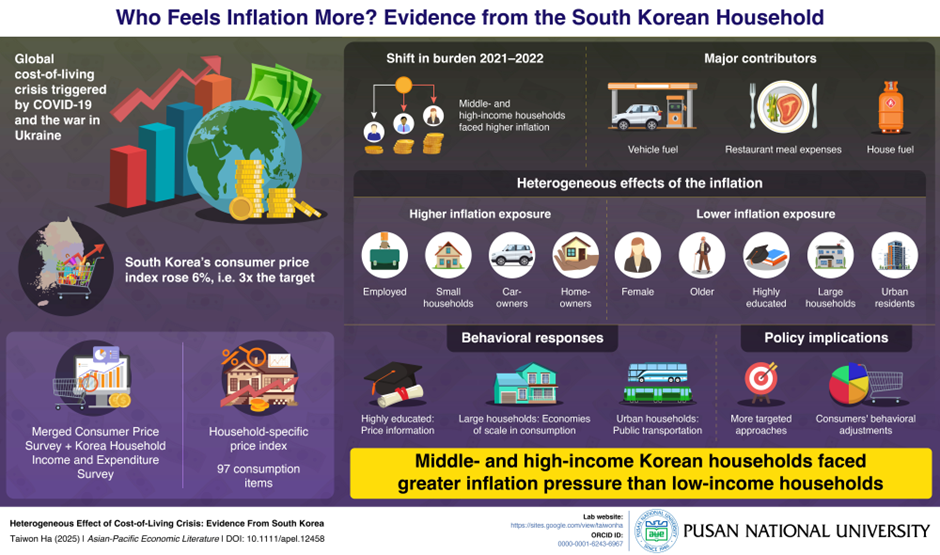
Reveal Middle-Class Families Hit Hardest by South Korea's Cost-of-Living Crisis
Researchers find that recent inflation disproportionately burdened middle- and upper-income households, challenging conventional views
As rising prices continue to strain household budgets around the world, understanding who is most affected by inflation has become more urgent than ever. Researchers found that the cost-of-living crisis hit middle- and upper-income households harder than the poorest. A recent study challenges the reliability of traditional inflation measures like the Consumer Price Index and offers fresh insights for designing smarter, more targeted relief policies.

Image title: Beyond the CPI: Uncovering Who Inflation Hits Hardest in South Korea
Image caption: South Korean commuters face rising fuel and meal costs, key drivers of inflation that hit middle-income households harder than the poor.
Image credit: Taiwon Ha from Pusan National University, South Korea
License type: Original Content
Usage restrictions: Cannot be reused without permission
As prices rose across the globe following the pandemic and the war in Ukraine, many expected the usual pattern, i.e., low-income households bearing the brunt of inflation. But in South Korea, they observed something exactly opposite to the usual scenario.
A new study by Dr. Taiwon Ha from Pusan National University, South Korea, available online on 04 June 2025, in the journal Asian-Pacific Economic Literature shows that upper-middle-income households experienced a higher price increase than the poor, who were typically more affected during past inflationary periods. “While the consumer price index (CPI) is generally used for policymakers and researchers, this composite index cannot represent specific effects on real life,” states Dr. Taiwon Ha.
By creating a household-specific price index and analyzing inflation’s impact across different income levels, the study provides a more detailed view of how cost-of-living pressures were felt in Korean households. Fuel and dining expenses emerged as the top drivers of inflation - expenses that are more common among employed, middle-income families who commute and eat out frequently. This phenomenon was not unique to Korea. Similar trends were seen in the U.S. and Europe, where middle-class families found themselves squeezed by transportation and service sector costs.
Yet CPI, the go-to metric for measuring inflation, failed to capture this divergence. That’s a problem, the study argues, because CPI “cannot fully represent the heterogeneous effects of inflation,” especially during volatile periods.
To bridge that gap, Dr. Ha decomposed the inflation spike into its specific contributors, such as oil prices and food, and examined how those impacts varied by household type. “This study provides more specific insights to support the policy-making process,” Dr. Taiwon explains, “such as who is more affected by price changes to design benefits, for example, either a targeted benefit or a universal benefit.”
The study found that female-led households, the unemployed, the highly educated, and the elderly were more likely to adjust their spending to mitigate inflation. Larger households and urban residents also managed better due to shared expenses or access to public transit.
The findings also suggest that policy responses need to evolve. For example, oil tax cuts may benefit car-owning commuters more than others, while food stamps or direct subsidies could help households unable to reduce spending. “This study can offer a meaningful complementary tool to CPI for policymakers,” Dr. Taiwon notes, “to gain a more specific picture in response to future inflation.”
Going forward, governments should monitor not just national inflation averages, but also how those changes are distributed across society. Household spending patterns, demographics, and consumption flexibility can all act as early warning signs for where economic pain will strike next.
To truly understand who is suffering the most, household-level data is essential. The study found that households with greater spending flexibility, particularly those led by women, the unemployed, or individuals with higher education, were better able to adapt to changing prices. These insights suggest that smarter, more targeted policy responses, such as focused benefits and improved access to price information, may be more effective than broad, untargeted subsidies. Ultimately, inflation is not just an abstract figure. It affects real lives. As inflation shocks continue to challenge economies worldwide, this research underscores the importance of informed, precise policymaking grounded in an understanding of both macro trends and household realities.
Reference
Title of original paper: Heterogeneous Effect of Cost- Of- Living Crisis: Evidence from South Korea
Journal: Asian- Pacific Economic Literature
DOI: 10.1111/apel.12458
About the Author
Prof. Taiwon Ha is a tenure-track assistant professor of Department of Public Administration at Pusan National University in South Korea. He completed PhD in Economics from University of Exeter in the United Kingdom. Moreover, he accumulated nearly 20 years of professional experience in the Korean government, such as Ministry of Economy and Finance and Statistics Korea, and United Nations ESCAP. His research interests include household well-being (income and consumption expenditure), public finance, welfare, poverty, and heterogeneous causal effect analysis.
Lab website address: https://sites.google.com/view/taiwonha
ORCID id: 0000-0001-6243-6967

 PURCS_162_Infographic_final.jpg
(2MB)
PURCS_162_Infographic_final.jpg
(2MB)